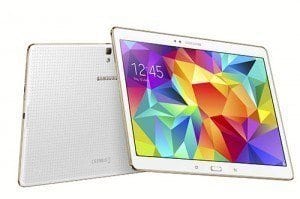
I’ve spent time with Samsung hardware in the past, reviewing their smartphones, tablets, and other hardware, and some of the feedback I’ve received regarding the benchmark results I include indicate that most readers consider the numbers arbitrary, even with superficial explanation. Instead, through Twitter and email, some have asked for a more “consumer friendly” review, discussing real-life situations and how the hardware responded.
Your wish is granted.
Earlier this week I spent nearly 48 hours traveling between New York City and my home in Maine. My wife and three year old daughter accompanied me, so I took the opportunity to put the Samsung Gear S, Note 4, and Galaxy Tab S to the test. I’m happy to say, for the sake of my own sanity, that it was impressively successful.
Samsung Galaxy Tab S

On Monday, January 12th, we got up at 2:30am to load the car, get ready for travel, and prepare for the tantrum that my daughter would inevitably have being woken up so early. I don’t blame her, I do the same thing. We got to the airport around 4am with a full charge in each device. After getting through the TSA check, adjusting the display settings (auto brightness is a battery killer), and activating the Wi-Fi, I had to sit my daughter down with the tablet to prevent her from running up the walls while we waited to board.
It was a one-and-a-half-hour flight to Washington D.C., then another 30 minute flight to New York City before taking a 25-ish minute car ride to the hotel in Times Square. The tablet was in use, playing children’s games with the volume on a very low setting, any time we weren’t walking, and by the time we arrived at the hotel it was down to 61% battery. Approximately three hours of nonstop use and the Galaxy Tab S still had more than half of the battery life available.
Note 4

Using the smartphone was far different than the tablet, more intermittent. It was only used when checking emails, text messages, Twitter, and Facebook, though some may say I do that far too much. By the time we had reached the hotel, I was still at a solid 71% battery life, but heavy use was only just beginning. An hour charging at the hotel got the phone back to 100%, though it didn’t take the full hour to fully charge and unfortunately I didn’t check it to see how long it took to refill the 30%.
Unfamiliar with New York City, I was nearly 100% dependent on the Note 4 for directions, appointments, and other information. For instance, because we had so little time in the city, we had a few landmarks we wanted to investigate. With a toddler, there are a few key locations. We started at the Central Park Zoo and after touring that we a number of child-friendly shopping locations in and around Times Square.
By 4pm, when my daughter fell asleep on my shoulders, we ended up back at our hotel. With more than five hours without a charge, with heavy use, the Note 4’s battery was rock solid, still above 50%, even with full audio (for directions), nearly a dozen phone calls, a pedometer in use, and a constant barrage of emails that required replies.
The one thing I noticed about the Note 4 was that, despite the inclusion of a stylus, complete with apps that make great use of it, I never found it necessary. Even before the trip, and since, I’ve not used it beyond forcing myself to see how it works and whether it’s useful. It’s not. And I live and die by my email, social media, and calendar appointments.
Gear S

I’ve had experience with smart watches in the past and was excited to see what would be offered in the Gear S because Samsung has a history of making impressive, reliable hardware. The Gear S isn’t any different, but I found myself wondering why some people think it’s necessary. It connects to your phone via Bluetooth, which I admittedly only turned on for a small portion of the trip in order to preserve battery for the phone.
I tried to make the most of the device, syncing a number of apps that would give me important information. Weather, the number of steps I had taken, and the time was the most useful, and even then it was only slightly more efficient than just looking at my phone. Beyond downloading a new background for it, which would trigger onlookers to smile or say, “Neat!” when they saw it, it simply wasn’t useful.
It could have been due to my own busy schedule or the fact that I own an analog watch, but there’s only one thing that wearing the Gear S did: it caused constant concern of draining my phone battery. And at the end of the day I had another device I had to remember to charge.
Day 2 was easier on the Galaxy S and Note 4 in the morning and afternoon (the Gear S had been packed away by that point), and we were back in the airport by 5pm, waiting our flight home. Again, my daughter was buried in the Galaxy S and I was back to the Note 4, scheduling the rest of my week. We landed back home a little after midnight, slogged our way back home, exhausted, and just went to bed. The Galaxy S and Note 4 still had a charge when we got up the next morning.
I couldn’t have been happier with the Samsung hardware. Even the Gear S isn’t a poor product and can be helpful to a degree, with a solid battery life and beautiful screen, but it seems there is a limit to it’s usefulness. The Note 4 battery life was surprising, given the screen size and the Galaxy S held up to a three year old and her obsession with Strawberry Shortcake apps. Through three states, six airports, four car rides, and Times Square, Samsung proved the Note 4, Galaxy Tab S, and Gear S can handle the task.















